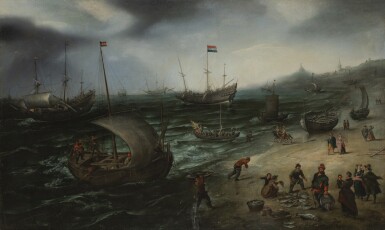Old Masters Evening Sale
Old Masters Evening Sale

The Property of a Family
Hendrick Cornelisz. Vroom
The fishing fleet coming ashore at Scheveningen, their unloaded catch displayed for sale, and a whaler and a man o' war in the offing | 《在席凡寧根泊岸的漁船,漁夫卸載漁獲,海面上的捕鯨船和戰艦》
Auction Closed
July 7, 06:31 PM GMT
Estimate
100,000 - 150,000 GBP
Lot Details
Description
The Property of a Family
Hendrick Cornelisz. Vroom
Haarlem circa 1563 - 1640
The fishing fleet coming ashore at Scheveningen, their unloaded catch displayed for sale, and a whaler and a man o' war in the offing
signed and dated on the flag upper centre: VROOM/ 1607
oil on canvas
97 x 159.6 cm.; 38¼ x 62¾ in.
家族收藏
亨德里克・科內利斯・弗魯姆
哈倫,約1563 - 1640年
《在席凡寧根泊岸的漁船,漁夫卸載漁獲,海面上的捕鯨船和戰艦》
款識:藝術家在中上方的旗幟上簽名並紀年ROOM/ 1607
油彩畫布
97 x 159.6 公分;38¼ x 62¾ 英寸
Julius Rosenberg, Berlin;
By whom sold, Frankfurt, Bangel, 24 October 1922, lot 78;
Frau Coray-Stoop, by 1923;
Her sale, Lucerne, Fischer, 29 July 1925, lot 31;
Galerie G. Giroux, Brussels;
Their sale, Brussels, 3–4 May 1957, lot 361;
Since then in a Belgian private collection (offered, London, Sotheby's, 6 July 2000, lot 52, £150,000–250,000, unsold);
By inheritance to the present owners.
L.J. Bol, Die Holländische Marinemalerei des 17. Jahrhunderts, Braunschweig 1973, p. 13, reproduced p. 15, fig. 9;
M. Russell, Visions of the Sea. Hendrick C. Vroom and the Origins of Dutch Marine Painting, Leiden 1983, p. 155, reproduced p. 156, fig. 137.
Hendrick Vroom was the first great marine painter, and the founder of the Netherlandish schools of marine painting. He had no forebears, and preceding depictions of marine subjects by Northern artists of which we are aware are scant: Frans Huys' engravings after Pieter Bruegel, a painting or two ascribed to Cornelis Anthonisz., and marine subjects in the background of world landscapes by Herri Met de Bles and others; in other words, very little. Vroom probably learnt more while in Italy, where he may have seen depictions of naval battles by Tintoretto, for example, and from the brothers Bril in Rome, but these influences do not explain the confidence and assuredness of even his early works, which do not look as if they are the first tentative exercises in a nascent genre.
Vroom came from a family of artists: his father was a sculptor and a maker of ceramics and both his uncle and grandfather were sculptors and stonemasons. Van Mander's account of Vroom's extensive travels throughout the Mediterranean both before and after his marriage, are almost certainly based at first-hand on Vroom's own storytelling, to judge by their somewhat vainglorious embellishing. In 1594, the year of his earliest surviving dated picture (in fact it does not survive, since it was destroyed in 1945, but photographs of it do), he was exempted from military service by the burgomasters of Haarlem ‘because of his unique skill in painting of marine subjects in which he excels all others’.1
According to Van Mander, writing in 1604, Cornelis Vroom was then already known for his beach scenes. This picture, dating from 1607, is the earliest such work to have come down to us, and the earliest of a genre that was to be widely practised in Haarlem and elsewhere in Holland from the 1620s until late in the century. It is in fact by some margin the earliest of Vroom's surviving beach scenes, since the others date from the 1620s and '30s, by which time other painters had started to depict similar scenes. His own later beach scenes, always showing fishing pinks coming ashore, and their catch being unloaded, have a progressively lower viewpoint and horizon line. This development can be seen in the picture of 1623, in which the horizon line runs across the picture plane just below the centre line (formerly with P. de Boer, Amsterdam), and another of 1635, in which sea and land extend less than one third of the height of the picture.2 The present work, by comparison, deploys the conventional Mannerist bird's eye perspective with a high horizon line, which, by comparison with his early dated marine paintings, confirms the date in the first years of the century.
1 K. van Mander.
2 The 1623 picture was formerly with P. de Boer, Amsterdam. The 1635 picture is in a Dutch private collection; see Russell 1983, reproduced p. 157, figs 138 a and b.
